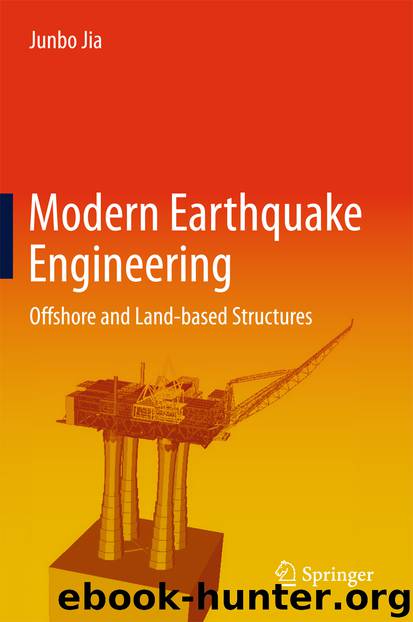Modern Earthquake Engineering by Junbo Jia

Author:Junbo Jia
Language: eng
Format: epub
Publisher: Springer Berlin Heidelberg, Berlin, Heidelberg
5.Scour and soil liquefaction around the structural foundation should be taken into account.
On the structural design and performance aspects:1.Structures should have an open system that allows water to flow through.
2.The structures should have sufficient ductility and redundancy , normally constructed with well-engineered reinforced concrete or steel frames.
3.The vertical evacuation structures must be outside the wave breaking zones.
12.7 Mitigation of Tsunami Hazard
Designs to mitigate tsunami hazard still need significant improvement as many infrastructures were damaged during large historic tsunami events. One well-known example is the accident at Fukushima Dai-Ichi nuclear power plant due to the tsunami induced by the moment magnitude 9.0 Sendai earthquake, Japan, 11 March 2011, caused core-melting of three units and a release of a large amount of radioactive material.
An efficient and economical means of tsunami hazard mitigation planning is to construct inundation maps along coastlines that are potentially vulnerable to tsunami flooding.
Efficient tsunami warning system and tsunami resistant structures and shelters are important measures to resist threats from tsunami. Many ancient and current reports state that the first obvious warning of a tsunami is when the sea recedes dramatically, leaving fish flapping on the former seabed. People go down to investigate and profit, and then the real tsunami comes. Moreover, it has been reported in Japan that a fierce wind often blew just before a tsunami arrived. All these phenomena are not fully understood so far. However, because the seismic waves containing information about earthquake fault travel 20 or 30 times faster than the tsunami waves, with the aid of computer models that are widely available, this gives scientists enough time to analyze seismograms, to estimate earthquake source parameters, and to forecast the expected tsunami propagation and wave height.
There are two major tsunami warning centers: the Pacific Tsunami Warning Center (PTWC) at Ewa Beach near Honolulu, Hawaii, and West Coast/Alaska Tsunami Warning Center (WC/ATWC) at Palmer, Alaska. When an earthquake of greater than magnitude 7.0 occurs and it is located offshore or beneath seafloor at open ocean, tsunami warnings, watches and information bulletins will be issued by these two warning centers. Warnings of a damaging tsunami are issued for the location within a 3 h travel time from epicenter. All communities within 3–6 h travel time from the epicenter are put on tsunami watch, meaning that an earthquake that has a potential to induce a tsunami has occurred and local bodies should be on the alert for further information. Tsunami information bulletins are issued to locations farther than 6 h travel time from the epicenter . This also works as an alert for the local authorities. On the other hand, tsunami information bulletin is also issued when there is no tsunami threat posed by a particular significant earthquake [39]. As an example of the efficiency of a warning system, during the tsunami triggered by the magnitude 9.0 Sendai earthquake, the length of warning time residents at Sendai had before the tsunami hit was around 8–10 min. It is worth mentioning that a similar warning system did not
Download
This site does not store any files on its server. We only index and link to content provided by other sites. Please contact the content providers to delete copyright contents if any and email us, we'll remove relevant links or contents immediately.
Man-made Catastrophes and Risk Information Concealment by Dmitry Chernov & Didier Sornette(5639)
The Revenge of Geography: What the Map Tells Us About Coming Conflicts and the Battle Against Fate by Kaplan Robert D(3955)
Zero Waste Home by Bea Johnson(3646)
In a Sunburned Country by Bill Bryson(3359)
COSMOS by Carl Sagan(3346)
Good by S. Walden(3343)
The Fate of Rome: Climate, Disease, and the End of an Empire (The Princeton History of the Ancient World) by Kyle Harper(2863)
Camino Island by John Grisham(2716)
A Wilder Time by William E. Glassley(2686)
Organic Mushroom Farming and Mycoremediation by Tradd Cotter(2563)
The Ogre by Doug Scott(2498)
Human Dynamics Research in Smart and Connected Communities by Shih-Lung Shaw & Daniel Sui(2430)
Energy Myths and Realities by Vaclav Smil(2377)
The Traveler's Gift by Andy Andrews(2297)
9781803241661-PYTHON FOR ARCGIS PRO by Unknown(2268)
Inside the Middle East by Avi Melamed(2230)
Birds of New Guinea by Pratt Thane K.; Beehler Bruce M.; Anderton John C(2174)
A History of Warfare by John Keegan(2097)
Ultimate Navigation Manual by Lyle Brotherton(2045)
